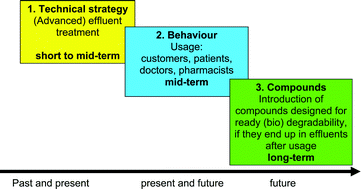Chemicals are a part of modern life. Products are the main emissions of the chemical and pharmaceutical industries. This makes it difficult to hold them back efficiently. Very often they do not become degraded or fully broken down to water, carbon dioxide and inorganic salts. Often, unknown transformation products are formed in the environment. Therefore, according to the principles of green chemistry, the functionality of a chemical should not only include the properties of a chemical necessary for its application, but also easy and fast degradability after its use. Taking into account the full life cycle of chemicals will lead to a different understanding of the functionality necessary for a chemical. In the present discussion, improvement of synthesis and renewable feedstock are very prominent, whereas the environmental properties of the molecules are somewhat underestimated. To stimulate the discussion about the future role of degradable chemicals several examples are presented to underline the feasibility and the economic potential of this approach, called benign by design.

You have access to this article
 Please wait while we load your content...
Something went wrong. Try again?
Please wait while we load your content...
Something went wrong. Try again?


 Please wait while we load your content...
Please wait while we load your content...